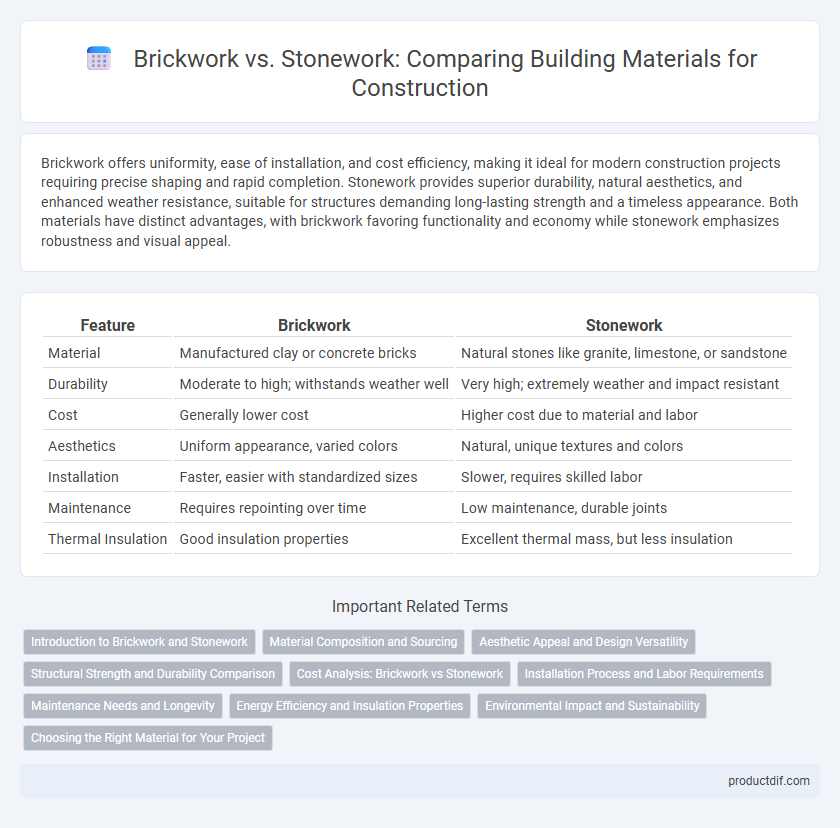Brickwork offers uniformity, ease of installation, and cost efficiency, making it ideal for modern construction projects requiring precise shaping and rapid completion. Stonework provides superior durability, natural aesthetics, and enhanced weather resistance, suitable for structures demanding long-lasting strength and a timeless appearance. Both materials have distinct advantages, with brickwork favoring functionality and economy while stonework emphasizes robustness and visual appeal.
Table of Comparison
| Feature | Brickwork | Stonework |
|---|---|---|
| Material | Manufactured clay or concrete bricks | Natural stones like granite, limestone, or sandstone |
| Durability | Moderate to high; withstands weather well | Very high; extremely weather and impact resistant |
| Cost | Generally lower cost | Higher cost due to material and labor |
| Aesthetics | Uniform appearance, varied colors | Natural, unique textures and colors |
| Installation | Faster, easier with standardized sizes | Slower, requires skilled labor |
| Maintenance | Requires repointing over time | Low maintenance, durable joints |
| Thermal Insulation | Good insulation properties | Excellent thermal mass, but less insulation |
Introduction to Brickwork and Stonework
Brickwork involves the use of uniform clay bricks bonded with mortar, offering consistent strength and thermal insulation in construction. Stonework utilizes natural stones, providing exceptional durability and aesthetic appeal due to its varied textures and colors. Both materials play crucial roles in structural integrity and architectural design, with brickwork suited for precision and stonework favored for natural resilience.
Material Composition and Sourcing
Brickwork primarily uses clay or shale bricks fired at high temperatures, ensuring uniform size and strength, while stonework involves natural stones such as granite, limestone, or sandstone, sourced directly from quarries with varied textures and durability. The homogeneity of brick materials allows for consistent structural performance and ease of mass production, whereas stonework offers distinctive aesthetic qualities derived from geological variations and mineral compositions. Efficient sourcing of bricks centers on industrial manufacturing processes near clay deposits, contrasting with stonework's reliance on location-specific quarrying that influences transportation costs and environmental impact.
Aesthetic Appeal and Design Versatility
Brickwork offers a consistent texture and color palette that enhances architectural styles with clean lines and uniform patterns, making it ideal for modern and traditional designs alike. Stonework provides unique natural variations and a timeless aesthetic, delivering a rugged, organic charm perfect for rustic, classical, or bespoke projects. Both materials contribute significantly to facade character, but stonework allows greater design versatility through varied shapes and finishes, while brickwork excels in modular, repetitive patterns.
Structural Strength and Durability Comparison
Brickwork offers consistent compressive strength ranging from 7 to 50 MPa, making it reliable for load-bearing walls, while stonework typically exhibits higher strength values up to 200 MPa, contributing to superior structural stability. Durability in stonework surpasses brickwork due to natural resistance against weathering, erosion, and chemical damage, extending the lifespan of stone constructions beyond a century. Both materials provide robust structural integrity, but stonework's higher density and lower porosity enhance long-term resilience in harsh environmental conditions.
Cost Analysis: Brickwork vs Stonework
Brickwork generally offers a lower initial cost compared to stonework due to the affordability of raw materials and faster installation times, making it a budget-friendly choice for construction projects. Stonework demands higher expenditure because of the labor-intensive process, specialized skill requirements, and the cost of natural stone, which significantly increase overall expenses. Long-term maintenance costs also differ, with brickwork requiring less frequent repairs and stonework providing enhanced durability that may offset upfront investment over time.
Installation Process and Labor Requirements
Brickwork installation involves laying uniform, kiln-fired bricks with consistent mortar joints, requiring precise alignment and skilled masons to ensure structural integrity and aesthetic appeal. Stonework demands more labor-intensive techniques due to irregular shapes and sizes, necessitating custom cutting, fitting, and specialized tools, which increases installation time and craftsmanship requirements. Labor costs for stonework typically exceed brickwork because of these complexities and the need for experienced stonemasons to handle heavy materials and achieve proper bonding.
Maintenance Needs and Longevity
Brickwork typically requires less maintenance due to its uniform structure and resistance to weathering, making it ideal for long-term durability. Stonework, while often more durable and resistant to impact, demands regular inspection and occasional repointing to prevent moisture infiltration and structural degradation. Both materials offer excellent longevity, but brickwork offers a more cost-effective and lower-maintenance solution over time.
Energy Efficiency and Insulation Properties
Brickwork offers superior energy efficiency due to its thermal mass, which helps regulate indoor temperatures by absorbing and slowly releasing heat. Stonework, while durable and aesthetically appealing, generally provides lower insulation properties because of its higher thermal conductivity, often requiring additional insulation layers to achieve comparable energy performance. Both materials impact overall building insulation, but brick's inherent properties make it more effective in reducing heating and cooling costs.
Environmental Impact and Sustainability
Brickwork generally has a higher carbon footprint due to energy-intensive firing processes compared to stonework, which often involves less processing and extraction emissions. Stonework's durability and natural sourcing contribute to sustainability by reducing the need for frequent repairs and replacements, lowering overall environmental impact. Sustainable building projects prioritize locally sourced stone to minimize transportation emissions and utilize recycled or manufactured bricks designed for energy efficiency.
Choosing the Right Material for Your Project
Brickwork offers uniform shapes and sizes, making it ideal for precise construction and faster installation, while stonework provides natural durability and unique textures that enhance aesthetic appeal. The choice depends on factors like project budget, structural requirements, and desired architectural style, with brick often preferred for cost-efficiency and stone for longevity. Evaluating environmental conditions and maintenance expectations ensures selecting the right material aligns with both functional and design goals.
Brickwork vs Stonework Infographic

 productdif.com
productdif.com